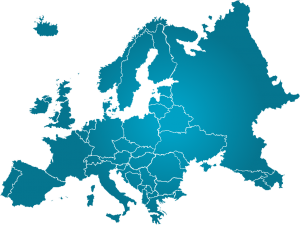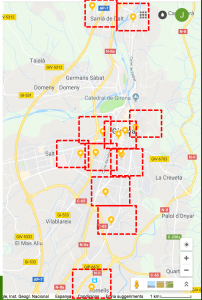I. Information about the chosen schools
1. Where is/are the school(s) located (name of city, urban/sub-urban/rural)?
The city of Girona has been chosen (Urban & sub-urban)
2. What kind of school(s) has/have been chosen (nursery, primary, secondary etc.)?
Mainly primary schools
3. How far is/are the school(s) away from busy roads?
It varies from school to school. Some schools are next to busy roads (playground is literately next to it, others are further away)
4. What kind of buildings surround the school(s) (e.g. is it located in a street canyon)?
Some schools are located within Street Canyons others are open with no buildings in the vicinity.
5. Do you have information on the traffic volume and/or the kind of vehicles passing in front of the school and/or on the neighbouring streets? If yes, please provide this info.
Info on traffic counts is not available, some estimates could be done.
6. Please provide an electronic ‘snap shot’ map of the
- city or district where the school(s) is/are located, and of

- school’s/schools’ close surroundings.

7. Other information, which you would like to share about the schools?
—
II. Information about the measurement approach
1. What kind of passive samplers do you plan to use, or which ones have you already used to measure NO2? How many?
- Palmes diffusion tubes will be used for 2 or 4 week exposure
- 20 locations will be chosen around each of the 10 schools
- They have already trialled this approach at 2 schools in 2018
2. Do you plan to use or have already used sensors to measure PM? If yes, which ones? How many?
- They don’t plan to use PM sensors at all schools
- Maybe they will use some light scatter (low-cost sensors) for some periods to show the morning and afternoon peaks
3. Do you plan or have you already compared results of your measurement equipment with or calibrated against official measurement stations?
Comparison of measurement equipment with against official measurement stations is available, (4sfera Innova) has performed and used NO2 passive samplers across Spain and other parts of Europe. In particular, colocation studies in Girona are very good and perform according to the indicative nature of the Passive Samplers. Usually results are within +/-10% of the results using reference equipment.
4. Where do you plan to locate or have already located the measurement devices? If possible, please indicate this on the map(s) mentioned under I.), or provide coordinates.
- Section I shows a map with chosen schools in the area. The exact location will be determined together with pupils at each school
- One of the piloted schools has already trialled the exercise with the following results
5. Please provide also info on the close surroundings of the measurement devices, e.g. in front of school (busy street, street canyon etc.), in the schoolyard, in the surroundings of the school(s).
Locations will vary from school to school. However, the proposal is that the location type vary to obtain a clear picture of the situation
6. Which sampling period(s), i.e. months have you chosen?
The measurement period will (ideally) be May-June and then September-October. However, if May-June is not possible they will do September-October and then October-November.
7. Do you also plan to count vehicles, vehicle types?
Vehicles, vehicle type counts are not planned.
III. Communication with pupils, teachers, parents
Foster engagement: Communicating about the project
1. Please indicate if you have any communication material already available and, if yes, what kind of material they are, e.g. from previous initiatives that can be useful for other participants.
Spain has some draft material from other initiatives that they might use to provide instructions on the campaign
2. Do you plan to cooperate with local administration responsible for air quality, traffic, urban planning etc.? If yes, which ones.
Cooperation is planned with local administration responsible for air quality, traffic, urban planning: Ajuntament de Girona, Ajuntament de Sarrià de Ter i Ajuntament de Salt, Generalitat de Catalunya
3. Are there any civil society initiatives or communities that are active in that domain in your countries? Which ones? They might have some useful communication material and contacts.
—
Citizen science and behaviour change: capturing long-term impacts
4. How do you plan to ‘measure’ change in behaviour, see for example the before-after questionnaire used by ‘Curious Noses’?
—
5. Some concrete questions have been suggested in relation to the citizen science approach:
- Can citizen science be used as a means of changing mobility behaviours in and around schools that influence air quality?
- What ways of citizen science can be employed to changing such behaviour?
- How effective are these ways of citizen science in changing mobility behaviour influencing air quality?
What kind of question(s) have you formulated?